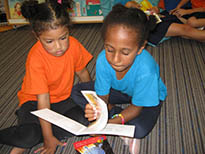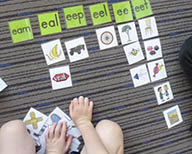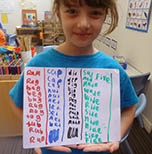


Literacy Learning at SCECS
The study of English is central to the learning and development of all young Australians. It helps create confident communicators, imaginative thinkers and informed citizens. It is through the study of English that individuals learn to analyse, understand, communicate with and build relationships with others and with the world around them. Australian Curriculum English Rationale-ACARA
At Southern Cross Early Childhood School we have established a series of core beliefs around literacy learning, which underpin our teaching and learning cycles:
- Because we believe all children are writers… at Southern Cross you'll see writing every day.
- Because we believe all children can find joy in books…at Southern Cross you'll see reading every day.
- Because we believe children learn in different ways…at Southern Cross you'll see our educators providing different ways to learn.
- Because we believe learning should be fun…at Southern Cross you'll see children engaged in fun, hands on and valuable learning experiences.
- Because we believe children's writing should be meaningful and relevant…at Southern Cross you'll see authentic examples and connections within play spaces.
- Because we believe children should be exposed to and immersed in literacy …at Southern Cross you'll see educators modelling speaking, listening, reading and writing behaviours and explicitly naming and teaching reading and writing strategies.
10 Essential Instructional Practices in Early Literacy
At Southern Cross Early Childhood School, we use the 10 Essential Instructional Practices in Early Literacy as a framework to support research and evidence-based teaching and learning across both services (Anglicare Education and Care and Southern Cross Early Childhood School). These 10 Essential Practices frame our planning, teaching and assessment.
Birth to 3: The focus of these practices is on individual interactions with children. Pedagogy focuses on infants and toddlers, as the first 3 years of life are when children learn the fastest and acquire the foundational skills that will support their development and learning for the rest of their lives. Improving language and literacy experiences in the infant and toddler years has the potential to improve literacy outcomes. Early childhood programs can also help to address disparities in literacy achievement.
Resource for families: Language and Literacy for Littles and Loved Ones
Literacy starts early. Did you know you can support your child’s future reading and writing before they can even talk? Babies come into the world ready to learn. Everything young children learn about communication, language, books, and printed words on their way to formal reading and writing is part of emergent literacy. Families have literacy superpowers. Do you know the many ways you already support your child’s language and emergent literacy? It doesn’t take flash cards, tablets, or fancy books. There are many ways you support language and emergent literacy in your everyday interactions with your baby or toddler. Whether you know it or not, you have literacy superpowers.
https://drive.google.com/file/d/1ZzcpQmuh2_tlqcU-onkGTUYyY5TujXfq/view
Preschool: Quality early childhood education can help improve literacy outcomes and preschool education can also address disparities in literacy achievement. The focus of these practices is on classroom practices that we can provide for all children every day. Research suggests that each of these ten practices can have a positive impact on literacy development. Teachers at Southern Cross Early Childhood School use these 10 practices alongside the Early Years Learning Framework to ensure children are accessing quality teaching and learning through play and inquiry every day.
Kindergarten to Year 3: Early elementary education can help improve literacy proficiency outcomes. The focus is on classroom practices that we can provide for all children every day. Research suggests that each of these ten practices can have a positive impact on literacy development. Teachers at Southern Cross Early Childhood School use these 10 practices alongside the Australian Curriculum to ensure children are accessing explicit quality teaching and learning every day.
A summary of the 10 Essential Instructional Practices for preschool and K-3 are listed below:
| Preschool | Kindergarten - Year 3 | |
|---|---|---|
| 1 | Intentional use of literacy artefacts in dramatic play and throughout the classroom | Deliberate efforts to foster literacy motivation and engagement within and across lessons |
| 2 | Read aloud with reference to print | Read alouds of age-appropriate books and other materials, print or digital |
| 3 | Interactive read aloud with a comprehension and vocabulary focus | Small group instruction, using a variety of grouping strategies, most often with flexible groups formed and instruction targeted to student’s observed and assessed needs in specific aspects of literacy development |
| 4 | Play with sounds inside words | Activities that build phonological awareness (Years K and 1 and as needed thereafter) |
| 5 | Brief, clear, explicit instruction in letter names, the sound(s) associated with the letters, and how letters are shaped and formed | Explicit instruction in letter-sound relationships |
| 6 | Interactions around writing | Research-informed and standards-aligned writing instruction |
| 7 | Extended conversation | Intentional and ambitious efforts to build vocabulary and content knowledge |
| 8 | Provision of abundant reading material in the classroom | Abundant reading material and reading opportunities in the classroom |
| 9 | Ongoing observation and assessment of students’ language and literacy development that informs their education | Ongoing observation and assessment of students’ language and literacy development that informs their education |
| 10 | Collaboration with families in promoting literacy | Collaboration with families in promoting literacy |
The Workshop Model
In addition to the 10 Essential Instructional Practices in Early Literacy, we use the Workshop Model as a structure for the delivery of our reading and writing learning. The Reader’s and Writer’s Workshop Model is a structure that allows teachers to explicitly teach reading strategies and to build a love of reading. Unlike other structures, the Reader’s and Writer’s Workshop Model allows children to spend most of their time engaged in reading and reading a wide range of literature that allows for choice and independence.
The Reader’s Workshop Model includes:
Introduction of the lesson: Teacher introduces the lesson with a learning intention.
Teacher may ask when planning- What’s the purpose of this lesson? What daily target will help us reach our long-term goals?
Explicit one third: Teacher demonstrates the focus that would usually include modelling using a planned and purposeful read aloud, modelled writing or interactive writing.
Teacher may ask when planning- What will children need from me to be successful? (Modelling, think-a-louds, demonstrations, etc.)
Sustained Reading, small catch groups and/or individual conferencing: Children practice their reading goal/strategy, uninterrupted. During sustained practice time, the teacher works with individuals (conferencing) or small catch groups. Conferences and small catch groups are planned ahead of time and reflect teacher’s decisions based on assessment data.
Teacher may ask when planning- What will children do to get smarter and reach our target? What will they read? What will they write? What will they talk about? What will they make, say, or do to demonstrate understanding?
Reflection: Time for children to reflect on what they have learnt and how they have applied the focus skill, knowledge or understanding.
Teacher may ask when planning- How will children share their learning? How can ALL children reflect during this time as opposed to one child sharing their learning with the whole group.
